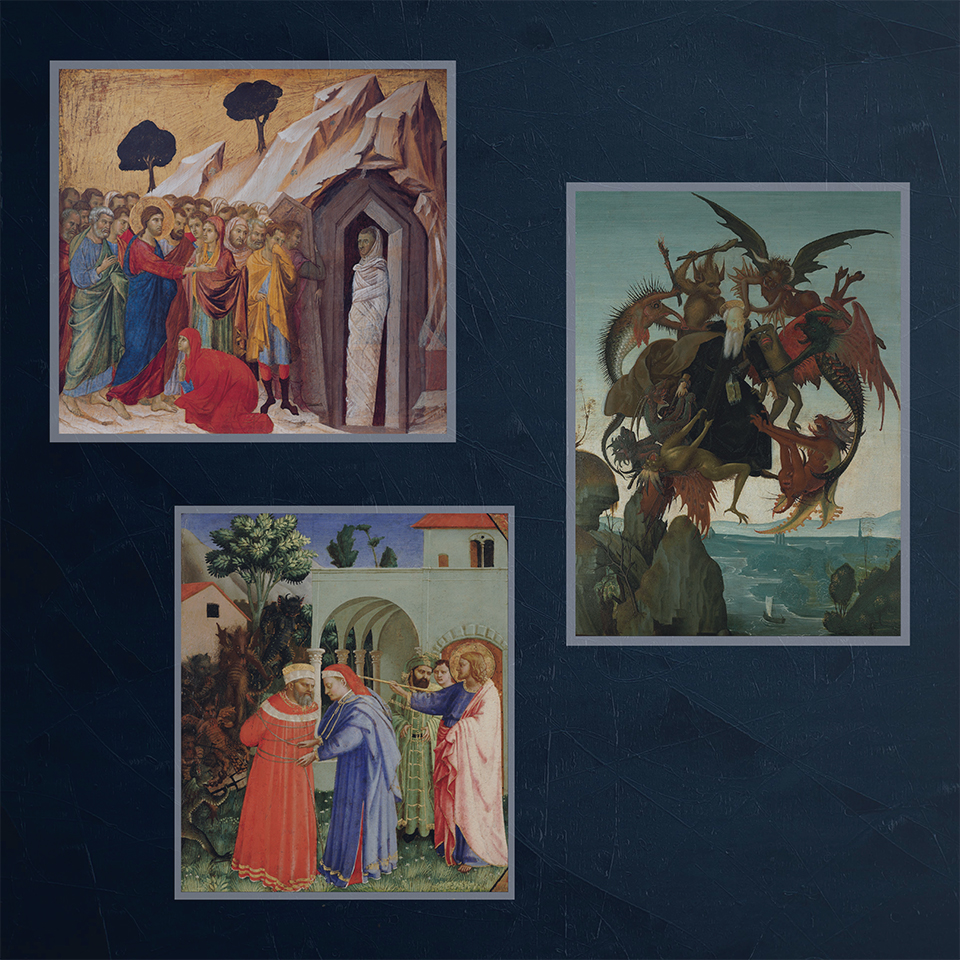Pope Benedict XVI often said that “art and the saints are the greatest apologetic of the faith.” This certainly rang true for me during a recent visit to the Kimbell Art Museum in Fort Worth, Texas.
I was not expecting this museum to house such masterpieces of the faith. A colleague of mine invited my wife and I to see the special exhibit Flesh and Blood from the Capodimonte Museum in Naples, Italy. As we were waiting for our friend, my wife and I wandered the Kimbell art gallery, and the first three piece that I saw got me thinking about freedom in Christ. The three masterpieces were Duccio’s The Raising of Lazarus (1310), Michelangelo’s The Torment of St. Anthony (1487), and Fra Angelico’s The Apostle St. James the Major Freeing the Magician Hermogenes (1426). They manifested an apologetics of the faith that brought to mind Galatians 5:1: “It is for freedom that Christ set us free.”
Christ specifically frees us from sin and death. This is God’s will for us. The Catechism states, “[God’s] will was that men should have access to the Father, through Christ, the Word made flesh, in the Holy Spirit, and thus become sharers in the divine nature.” Sin and death cut us off from the divine nature, and the Gospels proclaim God’s great gift of elevating us to a divine nature through Christ and in the Holy Spirit. Most of us do not know what this freedom looks like, but we need look no further than the saints and great Christian art.
Duccio’s Raising of Lazarus was the first and oldest of the three paintings I first encountered. It is iconographic in style. Some scholars believe Duccio learned the Byzantine iconographic tradition while studying in Constantinople. It is clearly on display in his art but with a dynamism lacking in some Byzantine icons in how he paints Christ’s saving activity. It depicts the raising of Lazarus from death (the consequence of sin). As the ultimate denial of life, death is the furthest thing from God but not more powerful than him. In this painting, Lazarus is entirely bundled up in his grave garments, as if to depict sin—but the garments are white. And I think this is no accident The white burial garments could also depict a foreshadowing of Lazarus partaking in the baptism in Christ. In the Gospel of John (John 11:1-44), the raising of Lazarus is the seventh sign prefiguring Christ’s Resurrection. Christ reaches out to Lazarus, calling him to himself just as God calls the cosmos out of the tohu-wa-bohu. Lazarus, representing all of mankind buried in sin but hopeful in God’s salvation, gazes back at Christ and is drawn into the community centered around him (the Church). The golden background sets this scene in eternity, so as to bring all of us sinners like Lazarus out of death into Christ.
The second painting was Michelangelo’s Temptation of St. Anthony. It has always been a favorite of mine, so I was shocked it was in Fort Worth. I used to have a meme wall in my classroom on which this painting had prominence of place. The meme has St. Anthony saying, “Whatever” because there is something quite funny about St. Anthony’s total indifference to the monstrous demons tuggng away at him—especially the demon with a butt face. But, at a deeper level, St. Anthony’s indifference shows us his freedom, which drives the demons insane. Try as they must, the demons hold no power over him, for he belongs to Christ. St. Anthony exists in the freedom of Christ where “neither death, nor life, nor angels, nor principalities, nor present things, nor future things, nor powers, nor height, nor depth, nor any other creature will be able to separate us from the love of God in Christ Jesus our Lord” (Rom. 8:38-39). Interior freedom drives the demons of the world insane, especially fish demons.
Like Michelangelo’s painting, Fra Angelico’s The Apostle St. James the Greater Freeing Magician Hermogenes has demons but shows someone in the grips of demonic bondage. The painting is of a story from medieval hagiography The Golden Legend in which St. James the Greater, through the power of Christ, sends convert Philetus to unbind Hermogenes from the demons he, Hermogenes, had originally summoned to attack the Apostle. Love of one’s enemy is on clear display in St. James’ action. Christianity has always taken demons very seriously, but unlike dualisms that give equal weight to good and evil, Christians are not frightened by the demonic as if Satan and his demons are more powerful than Christ. Christ has already despoiled them and made a public spectacle of them (Col. 3:15). Nevertheless, they continue to squabble and lead souls astray, forming the inverse of the Body of Christ with Satan at its head. Christ our Savior is in his Church, and his saving power is mediated to us through the sacraments and the successors to his Apostles, the bishops. This painting made me grateful for the bishops, bringing to mind Matthew 16:18: “And I also say unto thee, that thou art Peter, and upon this rock I will build my church; and the gates of Hades shall not prevail against it.” The freedom of a Christian is confident since the heart of the Church is pure, and Christians can go out confidently and draw others into liberation in Christ knowing that Christ and his Body are finally immune to the slavery of sin.
These paintings have been lingering in my memory as true witnesses to the faith. And like these paintings we are meant to let Christ make us into living icons of his love, encouraging the world to find its freedom in him. Texans claim to love freedom and the faith, so I guess I shouldn’t have been too surprised to find a great witness to the deepest freedom of faith on display in the Cowboy capital of the world.
